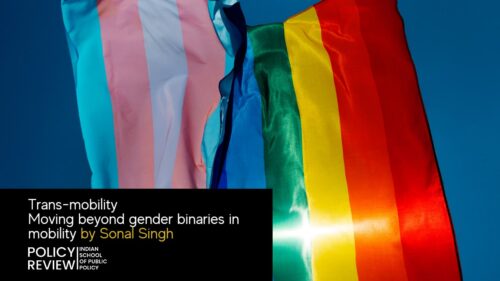
Trans-mobility: Moving beyond gender binaries in mobility

The Supreme Court, in its landmark judgment in the NALSA vs Union of India case, interpreted ‘dignity’ under Article 21 of the Constitution to include diversity in self-expression which allowed a person to lead a dignified life. Within this larger debate of dignity and access to livelihood, the right to mobility becomes crucial as it is linked to social and economic empowerment. However, the transgender community continues to face harassment due to the deep-seated socio-cultural biases against them.
Studying urban public transport through the cisgender lens has been a popular practice. This everyday experience becomes discriminatory for gender minorities. Even though the transgender community constitutes a tiny (0.04%, 2011 Census) fraction of the population, it is one of the most vulnerable communities. Transmobility is an emerging concept where public policy adopts a rights-based approach driven by progressive judgments and legislation to transition policies from being gender-neutral to gender-inclusive in line with the demands of the LGBTQA+ movement.
The nature and extent of violence faced by transgender and gender non-conforming individuals depend on the visible gender markers that make them prone to harassment and violence. The verbal and non-verbal interactions with fellow passengers further add to the feeling of alienation and hinder their accessibility. Public spaces become a zone of contestation, and their everyday experiences further alienate them from the mainstream. Mode of transportation can also play an important role based on the proximity and number of fellow passengers. However, usually, both cis-het males and females indulge in discriminatory and abusive behaviour. In instances where there is no outright harassment, a sense of indifference prevails, further perpetuating the process of othering the community. However, even small acts of kindness can go a long way in ensuring inclusivity in urban mobility.
The first step in addressing an issue is its identification. In the Indian context, no major study has been undertaken on transgenders and urban mobility. The study of intersectionality between gender, mobility and public space becomes crucial in the Indian context. The studies on urban mobility have centred around the gendered nature of spatial segregation but failed to include gender minorities. Therefore, bringing the community to the table becomes an important first step. But, the lack of representation of members from the community within institutions becomes a big hindrance.
State-level interventions like gender-neutral signs and markers on modes of public transport can strengthen inclusivity. Also, undertaking awareness campaigns to tackle myths against the community may not stop all forms of violence, but it can encourage riders to intervene when a member of the community is being harassed. Giving them a platform to share their stories can be a powerful tool.
Therefore, to make our cities truly inclusive, it is important to move away from the approach of gender binaries while designing public policy. To build progressive cities, steps should be taken to improve accessibility and inclusivity for the gender-minorities. Progressive judgments like NALSA and legislations like the Transgender Persons (Protection of Rights) Act, 2019 need not be confined to the narrow conceptions of legality but need a wider lens of inclusivity as a roadmap for India @ 100.
Register your Interest to Study at ISPP
References
“NATIONAL LEGAL SERVICES AUTHORITY (NALSA) VS. UNION OF INDIA – South Asian Translaw Database – THIRD GENDER.” South Asian Translaw Database, 22 July 2020, translaw.clpr.org.in/case-law/nalsa-third-gender-identity.
Arundhathi (2022) Gender-based spatial segregation: ladies’ compartments in the Mumbai local trains, Gender, Place & Culture, DOI: 10.1080/0966369X.2022.2115980
Petra L. Doan (2007) Queers in the American City: Transgendered perceptions of urban space, Gender, Place & Culture, 14:1, 57-74, DOI: 10.1080/09663690601122309
Amy Lubitow, JaDee Carathers, Maura Kelly & Miriam Abelson (2017) Transmobilities: mobility, harassment, and violence experienced by transgender and gender nonconforming public transit riders in Portland, Oregon, Gender, Place & Culture, 24:10, 1398-1418, DOI: 10.1080/0966369X.2017.1382451
Kevin Hannam, Mimi Sheller & John Urry (2006) Editorial: Mobilities, Immobilities and Moorings, Mobilities, 1:1, 1-22, DOI: 10.1080/17450100500489189

